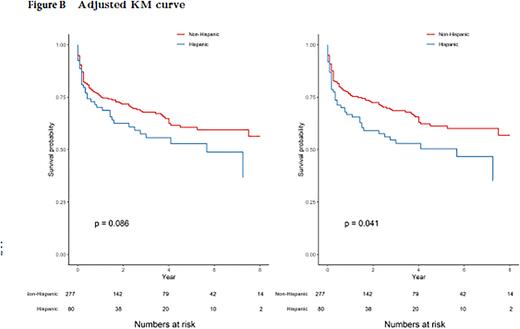Abstract
Background: Post transplant lymphoproliferative disorders (PTLD) comprises a heterogenous group of lymphoid neoplasm occurring after solid organ transplant and allogenic bone marrow transplant. The incidence has been rising and accounts for 21% of lymphoma in patients with solid organ transplant (PMID: 26742998). Despite significant advances in the field, the 5-year overall survival in retrospective study is around 56%. Most of these epidemiological studies have showed that race, age, and socioeconomic status was linked to poorer survival but most of the patients in these studies were Caucasians. WE aim to identify any differences in survival amongst Hispanic (HI) vs non-Hispanic population (NH) using large nationwide database.
Methods: This is a retrospective study of a cohort of patients diagnosed with lymphoma from the Surveillance Epidemiology and End Results (SEER) database. Patients with PTLD diagnosed from 2010 to 2018 were identified by the International Classification of Diseases for Oncology Third Edition (ICD-O-3) code list. Standard demographic variables collected include gender, race, ethnicity, age at diagnosis, subtype of lymphoma, stage, type of treatment, and vitality status among others. Categorical outcomes were summarized with frequencies and percentages and median age (years) was the only continuously distributed outcome with the median. The significance of variation in the distribution of categorical outcomes with ethnicity (HI, NH) was assessed with Fisher's Exact tests or Pearson's Chi-square tests as appropriate; median age was assessed with Wilcoxon tests. Survival time was measured in years from date of primary diagnosis to date of death. Patients not coded as dead were considered censored on survival time at the date last seen. Survival distributions were described with Kaplan-Meier curves and the significance of variation in median survival with ethnicity was assessed with log rank testing and proportional hazards models with propensity score weighting based on age. At risk tables were computed based on the Kaplan-Meier estimate of the survival curve. All statistical testing was two-sided with a significance level of 5%.
Results: A total 358 patients met inclusion criteria, with 80 HI and 278 NH diagnosed with PTLD from 2010 to 2018. Demographic data was analyzed and compared between both groups, (Fig A). About 57.5% HI were diagnosed at age <40 vs 42.8% in NH group. The most common site was lymph nodes and GI tract, which was equally involved in both groups, but HI groups had 13.8% CNS involvement vs 6.5% in NH group. The median survival time was similar between HI and NH, 5.7 years and not able to assess respectively. Survival probability at 2 and 5 years for HI was 0.62 (CI 0.524,0.747) and 0.52(CI 0.419,0.669) respectively. For NH the survival probability was similar, 0.71 (CI 0.664,0.776) and 0.60(CI 0.54,0.681) respectively. The overall survival probability at 5 years did not show a statistically significant difference for HI vs NH (p-value 0.08). However, after adjusting for age, HI have increased risk of death as compared to NH (P value 0.02) (Figure B)
Conclusion: PTLD has poor overall survival and low 5-year probability for all populations. Although when adjusted with age, HI have increased risk of death as compared to NH.
Disclosures
Diaz Duque:Morphosys: Consultancy; ADCT: Consultancy; Incyte: Consultancy; Astra Zeneca: Consultancy; Epizyme: Consultancy.
Author notes
Asterisk with author names denotes non-ASH members.


This feature is available to Subscribers Only
Sign In or Create an Account Close Modal